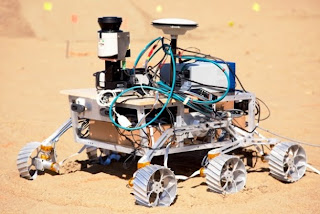
Engineers at Carleton University in Canada have demonstrated a small-scale rover that could be used as a risk-assessment tool in explorations of the surface of Mars and the moon.
The Kapvik micro-rover is inspired by design concepts seen in NASA's Sojourner, Spirit, and Opportunity rovers. It has six wheels, weighs less than 66 pounds, and could be deployed by larger unmanned rovers to scout out specific areas.
One problem that has dogged Martian rovers is getting stuck in sand or other topographic features. The Kapvik, named for an Inuktitut term for "wolverine," has a tethering system for winching it up hills.
The Canadian Space Agency is coordinating development of the rover, and partners include aerospace company MacDonald, Dettwiler and Associates as well as Toronto's Ryerson University, which created a utility arm that will collect surface samples and perform trenching operations.
Sensors planned for Kapvik include ultraviolet-visible spectrum, infrared imaging, and mapping tools to detect water and ice content.
Kapviks could serve as low-cost, adaptive rovers that would be remotely piloted and lower the chances of losing more elaborate, expensive rovers to inhospitable terrain.
Read more:
No comments:
Post a Comment